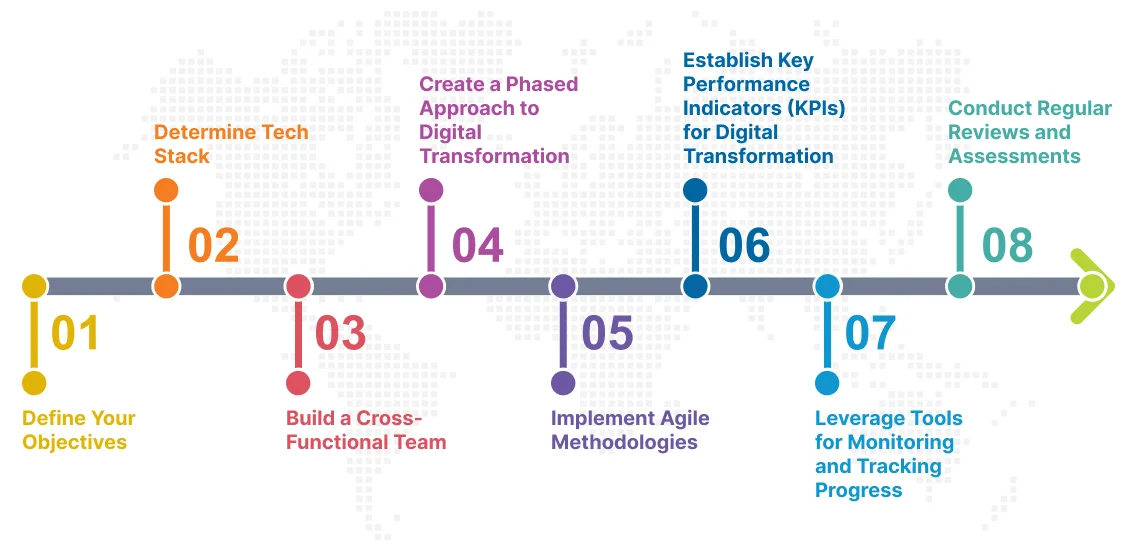How to Build Your Digital Transformation Strategy?
- Business
- May 6, 2024
At its core, digital transformation strategy is about effective implementation that streamlines processes and enhances efficiency through digital solutions. But here’s the catch: it is not a one-size-fits-all solution. It’s as unique as your business, tailored to your specific goals, challenges, and industry dynamics. That’s why it requires careful planning and collaboration. This blog guides you through the implementation process and helps you achieve desired outcomes.
Imagine a world where your business operates seamlessly across all digital platforms. Your business offers personalized customer interactions and uses data-driven insights to fuel innovation and growth. Sounds enticing, doesn’t it?
However, the path to achieving this vision isn’t always clear-cut. It traces to digital transformation strategy creation that requires careful planning, strategic thinking, and a willingness to embrace change. But where do you start?
What does digital transformation mean for your business?
How digital transformation benefits businesses?
Why is digital transformation a necessary asset for business?
How can you leverage digital technologies to create value for your customers and business?
What are the essential steps you need to take to craft a successful digital transformation strategy?
In this blog, we will provide you with practical insights and actionable advice to help you implement a digital transformation strategy with precision.
What is a Digital Transformation Strategy?
Digital transformation isn’t just about implementing new technologies; it’s about reimagining the entire business model and culture to adapt to the opportunities and challenges presented by the digital landscape.
Meanwhile, a digital transformation strategy is a comprehensive plan that organizations develop to leverage digital technologies and capabilities to fundamentally change their business processes, operations, products, services, and customer experiences.
It includes incorporating cutting-edge technologies into all aspects of a business that drive innovation, improve efficiency, and help businesses gain a competitive edge over their competitors.
A well-defined digital transformation strategy outlines clear objectives, identifies key areas for improvement, and establishes a roadmap for achieving organizational goals through digital initiatives.
For instance, consider a traditional brick-and-mortar retailer aiming to adapt to changing consumer preferences and online shopping trends. To stay relevant and competitive, the retailer develops a digital transformation strategy through an omnichannel approach.
The strategy involved implementing an e-commerce platform for online sales, integrating inventory management systems for seamless order fulfillment, and leveraging data analytics to personalize marketing campaigns and improve product recommendations.
By embracing enterprise digital transformation, the retailer not only expands its reach to online customers but also improves operational efficiency and gains valuable insights into consumer behavior, ultimately driving growth and success in the digital marketplace.
How an Effective Digital Transformation Strategy Transforms Businesses?
Digital transformation influences the business strategies, whereas an effective digital transformation strategy is essential to beat the market competition. The projected global expenditure on digital transformation is set to soar to $2.8 trillion by 2025. This staggering figure highlights the monumental shift towards digitalization across industries. Failure to invest in the digital future of your business could result in being left behind amidst this transformative wave.
According to Tech Pro Research, approximately 70% of companies have either implemented a digital transformation strategy or are actively developing one. Moreover, half of these companies report an annual increase in their digital transformation budgets. These statistics are proof of the growth DT will acquire in the future.
Therefore, digital transformation trends are here to stay and will strengthen its position in the future. Furthermore, to ensure continuity and competitiveness, organizations are preparing for these changes to make their businesses work more efficiently. That’s why it is important for companies to have an effective digital transformation business strategy.
It will help them leverage digital tools and solutions so companies can personalize their products and services and resolve customer issues while filling the gap in the market. They can tap potential problems their customers face and attain more growth and revenues. Moreover, automation, AI, and other digital technologies streamline business processes and reduce manual tasks, errors, and operational costs.
How to Create a Digital Transformation Strategy?
Creating a digital transformation strategy requires a systematic approach that aligns with your organization’s goals and priorities. Here’s a step-by-step guide to help you create an effective one:

1. Define Your Objectives
Analyze your organization’s strengths, weaknesses, opportunities, and constraints related to digital capabilities. Look for pain points, areas for improvement, and issues that digital transformation can address effectively.
Also, consider how digitalization can support and advance key business objectives, like revenue growth, market expansion, cost reduction, customer satisfaction, and product innovation.
For example, if you want to offer an amazing customer experience, you should focus on implementing a customer relationship management (CRM) system, improving website usability, or launching a mobile app.
On the other hand, if you want to provide convenience and improve accessibility, your objective should involve omnichannel sales strategy development, implementation of self-service options, or enhance mobile functionality.
2. Determine Tech Stack
Start this process by acknowledging the specific technology needs and requirements that align with your digital transformation objectives. Conduct a thorough analysis of the required tech infrastructure and decide on must-have software systems, tools, and technologies for your project while keeping scalability, interoperability, security, and compliance.
You must know which software applications, cloud-based services, data analytics tools, artificial intelligence (AI) platforms, customer relationship management (CRM) systems, and enterprise resource planning (ERP) software, among others. Include a reliable archive utility in your toolkit to handle unzipping downloaded applications, compressing files for efficient storage and backups, and preparing data for seamless online sharing, which can significantly streamline your digital workflows and file management processes.
3. Build a Cross-Functional Team
No strategy will ever work out if you don’t have a skilled team. You need to find the best digital transformation partner to build an expert and professional team. Once you choose the partner, make a well-rounded team by hiring individuals with diverse skill sets, expertise, and experience.
Divide roles and responsibilities to each member and assign specific tasks with their milestones to get the project done on time. Create communication channels and workflows to facilitate collaboration across different domains.
4. Create a Phased Approach to Digital Transformation
By creating a phased approach, organizations can plan, execute, and evaluate their digital transformation initiatives, minimizing risks, maximizing benefits, and ensuring sustained success in the digital age. Here’s how you can create it:
Phase 1
Achieve quick wins and demonstrate tangible progress to build momentum and support for the digital transformation strategy implementation. Identify small-scale projects that are easy to implement and have fewer requirements.
Phase 2
Upgrade legacy systems, invest in cloud infrastructure, mobile app development and implement foundational technologies such as CRM, ERP, or data analytics platforms.
Phase 3
Identify bottlenecks and inefficiencies in key business processes. Redesign workflows, automate manual tasks, and standardize processes to eliminate waste and improve operational efficiency.
Phase 4
Explore emerging technologies and identify use cases for AI in digital transformation areas. You can implement it to get customer insights, predictive maintenance, or personalized recommendations.
5. Implement Agile Methodologies
Choose an Agile framework that best suits your organization’s needs. You can pick from Scrum, Kanban, Lean, Scaled Agile Framework (SAFe), Extreme Programming (XP), etc. After this, customize the framework as necessary to fit the specific requirements of your digital transformation projects.
Introduce Agile practices and rituals, like sprint planning, daily stand-up meetings, sprint reviews, and retrospectives, facilitating communication, collaboration, and transparency.
Implement Agile tools and technologies to ensure task management and progress tracking. For the work, you can use Agile boards, digital Kanban tools, and collaboration platforms.
6. Establish Key Performance Indicators (KPIs) for Digital Transformation
Define clear, measurable outcomes or objectives that you want to achieve through your digital transformation initiatives. Choose metrics that directly align with the defined outcomes and offer valuable insights into the performance.
Establish a balance between leading indicators and lagging indicators. Use leading indicators to fetch insights into future performance trends like customer engagement metrics, innovation pipeline, etc. Also, take the support of lagging indicators to measure past performance outcomes like revenue growth, cost savings, etc.
Draft implementation strategies after considering customer-centric metrics (net promoter score, customer satisfaction), operational metrics (cycle time, process efficiency), financial metrics (ROI, cost per acquisition), and technology metrics (system uptime, software performance).
Establish specific targets, benchmarks, or thresholds for each KPI and track the progress over time. Identify and integrate relevant data sources, systems, or tools to capture and analyze the data needed to measure your selected KPIs effectively.
7. Leverage Tools for Monitoring and Tracking Progress
To ensure strategic execution you can use various types of tools. Some of them are as follows:
- Project Management Tools – Jira, Asana, Trello, or Microsoft Project
- Agile Tools – Agile boards, Scrum boards, or Kanban boards
- Business Intelligence (BI) Tools – Tableau, Power BI, or Google Data Studio
- Customer Relationship Management (CRM) Systems – Salesforce, HubSpot, or Zoho CRM
- Enterprise Resource Planning (ERP) Systems – SAP, Oracle, or Microsoft Dynamics
- Cloud-Based Analytics Platforms – Google Analytics, Adobe Analytics, or Mixpanel
By leveraging these tools and other elements of digital transformation effectively, you can track progress, enhance visibility, accountability, and decision-making throughout your digital transformation journey.
8. Conduct Regular Reviews and Assessments
Collect and compile relevant data, metrics, and insights related to the performance and outcomes of your digital transformation initiatives. Analyze the collected data and insights to identify trends, patterns, successes, challenges, and areas for improvement.
Look for discrepancies between planned vs. actual performance, root causes of issues, and emerging risks or opportunities. Detect challenges in digital transformation and try to overcome them.
To provide you with better insights into how businesses implement digital transformation strategies, explore our blog on “7 Examples of Business Transformation“. This blog highlights seven businesses and their successful digital transformation initiatives.
Factors You Must Consider While Implementing a Digital Transformation Strategy
When implementing a digital transformation strategy, several critical factors must be considered to ensure its success. Some of them are as follows:
C-Level Leadership
C-level leaders, including the CEO, CIO, CFO, and CMO, give a strategic direction to the implementation initiative. They take care of strategic alignment, resource allocation, change management, technology adoption, risk management, data-driven decision-making, etc.
Customer Centric Approach
Focus on what your customers want and need, and create digital experiences that are easy to use, personalized, and make them feel special. The customer-centric approach sets you apart from competitors and helps you build long-lasting relationships.
Also, pay attention to customer feedback and data to learn what they like or don’t like and make changes to improve their experience. The approach will bring you loyal customers, helping your business grow and succeed.
Data Governance and Security
It is important to pay attention to how you handle and protect your data if you’re changing the way your business uses technology. Effective data governance software helps you keep your data accurate, organized, and safe from third-party intrusion, hacking, and other cyber threats.
Data security assists you in putting up defences against malign activities that can cause harm to the business. By focusing on data governance and security, you can ensure your information stays safe and reliable.
Scalability and Future-Proofing
Scalability means that your systems and processes can handle the increased workload, traffic, and user demand and support business expansion operations. By designing scalable solutions, you can avoid expensive and disruptive upgrades in the future.
Meanwhile, future-proofing involves anticipating future trends and technology advancements to prevent your solutions from becoming obsolete. By investing in flexible and adaptable technologies, you can stay ahead of the curve and respond effectively to market changes and fluctuations.
Implementing a digital transformation strategy is more than just adopting new technologies—it’s about reimagining how we operate, connect, and thrive in a rapidly changing world. By following an accurate process, you can pave the way for a successful digital transformation journey, foster a culture of innovation, and evaluate and adapt to changes. To do so, you can avail digital transformation services from a reliable company. Professionals will guide you through the process.

How MindInventory Can Help You With Digital Transformation Strategy Implementation?
MindInventory is your dedicated digital transformation partner, providing efficacious digital transformation services, and helping you embrace the latest technologies and adapt to change with precision. With a keen eye on technological advancements and industry trends, our expert team brings unparalleled expertise and helps you leverage cutting-edge technologies like artificial intelligence, machine learning, blockchain, IoT, etc.
Through meticulous planning, agile execution, and continuous optimization, we ensure that every aspect of your digital strategy aligns seamlessly with your overarching business objectives. We don’t just promise digital transformation; we deliver results that drive tangible business value.
FAQs On Digital Transformation Strategy
Implementing a digital transformation strategy involves clear communication of objectives, securing buy-in from leadership and employees, establishing dedicated teams, allocating resources, fostering a culture of innovation and collaboration, monitoring progress, and adapting as needed.
The digital transformation strategy framework comprises five key domains- customer, competition, data, innovation, and value. These domains guide organizations through their transformation journey and support their growth.
To improve your digital transformation strategy, start by regularly reviewing and assessing your current initiatives and identify areas for enhancement. Invest in upskilling and reskilling your workforce to ensure they have the necessary digital competencies to drive transformation forward.













